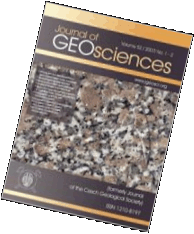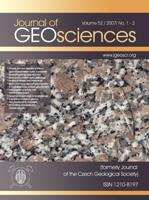 Export to Mendeley
Export to MendeleyOriginal paper
Astrophyllite-alkali amphibole rhyolite, an evidence of early Permian A-type alkaline volcanism in the western Mongolian Altai
Journal of Geosciences, volume 61 (2016), issue 1, 93 - 103
DOI: http://doi.org/10.3190/jgeosci.205
A dyke of alkali rhyolite intrudes the Tsetseg and Zuun Nuruu volcanosedimentary sequence of Ordovician-Silurian age (Hovd Zone, Central Asian Orogenic Belt) at the Botgon Bag, Mankhan Soum, Hovd District in Western Mongolia. The rock consists of quartz and K-feldspar phenocrysts set in fine-grained groundmass composed of quartz, K-feldspar, albite, blue alkali amphibole (riebeckite-arfvedsonite containing up to 1.94 wt. % ZrO2), tiny brown radial astrophyllite, annite and accessory zircon, ilmenite, fluorite, monazite, hematite, chevkinite and bastnäsite. Astrophyllite has unusual, highly ferroan composition and occurs as two sharply bound zones of astrophyllite I and II with the average empirical formulae:
(K1.71 Na0.01Rb0.08Cs0.01) (Na0.93Ca0.07) (Fe2+6.52Mn0.31Zn0.06) (Ti0.84Zr0.50Nb0.55) Si7.68Al0.32 O26 (OH)3.78 F0.66 (astrophyllite I, Zr-Nb-rich);
(K1.52Rb0.07) (Na0.81Ca0.19) (Fe2+6.31 Mn0.28Zn0.06) (Ti1.28Nb0.30Zr0.28) Si7.68Al0.32 O26 (OH)2.85 F0.67 (astrophyllite II).
Geochemically, the rhyolite corresponds to strongly fractionated silicic alkaline A-type (ferroan) magmatic rock with 75.5-75.9 wt. % SiO2, 4.4 wt. % K2O, 3.9-4.3 wt. % Na2O and 1.98-2.23 wt. % Fe2O3t, poor in CaO (0.26-0.37 wt. %), MgO (0.01-0.11 wt. %), and P2O5 (0.01 wt. %). The rock is enriched in Zr, Nb, Ta, Ga, Sn, Y, Rb, Cs, U and Th, depleted in V, Sr, Ba, Sc, and exhibits a pronounced negative Eu anomaly, (Eu/Eu* = 0.03-0.05). The conventional whole-rock K-Ar geochronology yielded an age of 299.9 ± 9.1 Ma (1σ), which indicates latest Carboniferous or early Permian extension associated with the A-type alkaline volcanic activity.
Webdesign inspired by aTeo. Hosted at the server of the Institute of Petrology and Structural Geology, Charles University, Prague.
ISSN: 1803-1943 (online), 1802-6222 (print)
email: jgeosci(at)jgeosci.org


IF (WoS, 2022): 1.4
5 YEAR IF (WoS, 2022): 1.8
Policy: Open Access
ISSN: 1802-6222
E-ISSN: 1803-1943